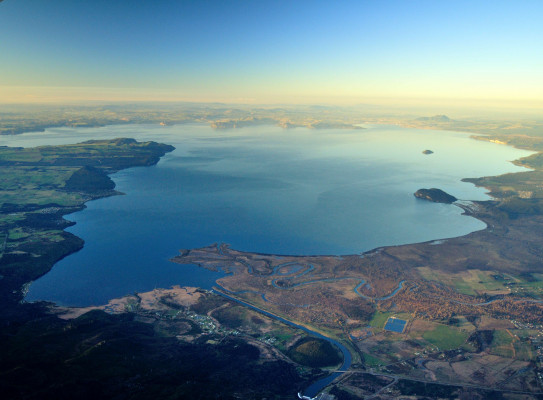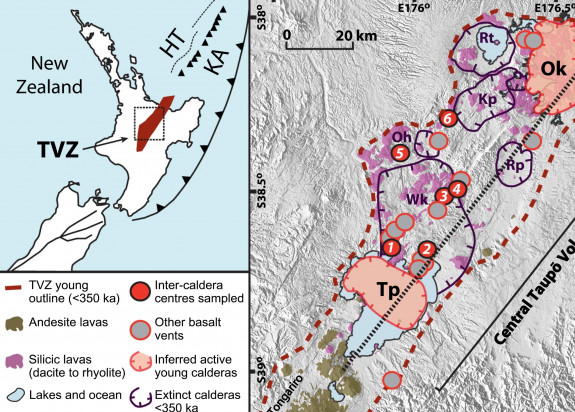Barker SJ, Rowe MC, Wilson CJN, Gamble JA, Rooyakkers SM, Wysoczanski RJ, Illsley-Kemp F, Kenworthy CC (2020) What lies beneath? Reconstructing the primitive magmas fueling voluminous silicic volcanism using olivine-hosted melt inclusions. Geology 48, 5p (link(external link))
Barker SJ, Wilson CJN, Illsley-Kemp F, Leonard GS, Mestel ERH, Mauriohooho K, Charlier BLA (2020) Taupō: an overview of New Zealand's youngest supervolcano, New Zealand Journal of Geology and Geophysics (link(external link))
Barker SJ, Van Eaton AR, Mastin LG, Wilson CJN, Thompson MA, Wilson TM, Davis C, Renwick JA (2019) Modeling ash dispersal from future eruptions of Taupo supervolcano. Geochemistry, Geophysics, Geosystems 20, 3375–3401 (link(external link))
Bebbington, MS (2020) Temporal-volume probabilistic hazard model for a supervolcano: Taupo, New Zealand. Earth and Planetary Science Letters 536 (link(external link))
Benson TW, Illsley-Kemp R, Elms HC, Hamling IJ, Savage MK, Wilson CJN, Mestel ERH, Barker SJ (2021) Earthquake analysis suggests dyke intrusion in 2019 near Tarawera volcano, New Zealand. Frontiers in Earth Science 8:606992 (link(external link))
Breard ECP, Jones J, Fullard L, Lube G, Davies C, Dufek J (2019) The permeability of volcanic mixtures – implications for pyroclastic currents. Journal of Geophysical Research 124 (2), 1343-1360 (link(external link))
Breard ECP, Dufek J, Lube G (2018) Enhanced mobility in concentrated pyroclastic density currents: An examination of a self fluidization mechanism. Geophysical Research Letters 45(2), 654-664 (link(external link))
Brosch E, Lube G, Cerminara M, Esposti-Ongaro T, Breard ECP, Dufek J, Sovilla B, Fullard L (2021) Destructiveness of pyroclastic surges controlled by turbulent fluctuations. Nature Communications. 12, 7306, (link(external link))
Brosch E, Lube G (2020) Spatiotemporal sediment transport and deposition in experimental dilute pyroclastic density currents. Journal of Volcanology and Geothermal Research 401:1-16. (link(external link))
Esposti-Ongaro T, Cerminara M, Charbonnier S, Lube G, Valentine GA (2020) A framework for validation and benchmarking of pyroclastic current models. Bulletin of Volcanology 82:51 (link(external link) - lead article for topical collection)
Gleeson M (2020) Mantle control on silicic volcanism. Nature Reviews Earth & Environment (link(external link))
Hamling IJ, Kilgour G, Hreinsdóttir S, Bertrand E, Bannister S (2022) Estimating the distribution of melt beneath the Okataina Caldera, New Zealand: an integrated approach using geodesy, seismology and magnetotellurics. (In press) Journal of Volcanology and Geothermal Research (link(external link))
Hamling IJ, Kilgour G (2020) Goldilocks conditions required for earthquakes to trigger basaltic eruptions: Evidence from the 2015 Ambrym eruption. Science Advances, 6:14 (link(external link))
Hamling IJ, Cevuard S, Garaebiti E (2019) Large-scale drainage of a complex magmatic system: Observations from the 2018 eruption of Ambrym volcano, Vanuatu. Geophysical Research Letters, 46(9), 4609-4617 (link(external link))
Hogg AG, Wilson CJN, Lowe DJ, Turney CSM, White P, Lorrey AM, Manning SW, Palmer JG, Bury S, Brown J, Southon J, Petchey F (2019) Wiggle-match radiocarbon dating of the Taupo eruption. Nature Communications 10, 4669 (link(external link))
Holdaway RN, Duffy B, Kennedy B (2018) Evidence for magmatic carbon bias in 14 C dating of the Taupo and other major eruptions. Nature Communications, 9(1), 4110 (link(external link))
Illsley-Kemp F, Barker SJ, Wilson CJN, Chamberlain CJ, Hreinsdottir S, Ellis S, Hamling IJ, Savage MK, Mestel ERH, Wadsworth, F (2021), Volcanic unrest at Taupō volcano in 2019: Causes, mechanisms and implications. Geochemistry, Geophysics, Geosystems 22,6 (link(external link))
Illsley-Kemp F, Barker SJ, Smith B, Wilson CJN (2020), Implications of a supervolcano’s seismicity, Eos, 101 (link(external link))
Illsley-Kemp F, Savage MK, Wilson CJN, Bannister S (2019) Mapping stress and structure from subducting slab to magmatic rift: Crustal seismic anisotropy of the North Island, New Zealand. Geochemistry, Geophysics, Geosystems 20:11, 5038-5056 (link(external link))
Jolley A, Dohaney J, Kennedy B (2022) Teaching about volcanoes: Practices, perceptions, and implications for professional development, Volcanica, 5(1), pp. 11–32. doi: .30909/vol.05.01.1132 (link(external link))
Kosik S, Bebbington M, Nemeth K (2020) Spatio-temporal hazard estimation in the central silicic part of Taupo Volcanic Zone, New Zealand, based on small to medium volume eruptions. Bulletin of Volcanology 82:50 (link(external link))
Lube G, Breard ECP, Esposti-Ongaro T, Dufek J, Brand B (2020) Multiphase flow behaviour and hazard prediction of pyroclastic density currents. Nature Reviews Earth & Environment 1: 348–365 DOI : 10.1038/s43017-020-0064-8 (link(external link) - Invited review)
Lube G, Breard ECP, Jones J, Fullard L, Dufek J, Cronin SJ, Wang T (2019) Generation of air lubrication within pyroclastic density currents. Nature Geoscience 12 (5): 381-386 (link(external link))
Myers ML, Wallace PJ, Wilson CJN, Watkins JM, Liu Y (2018) Ascent rates of rhyolitic magma at the onset of three caldera-forming eruptions. American Mineralogist 103, 952-965 (link(external link))
Myers ML, Wallace PJ, Wilson CJN (2019) Inferring magma ascent timescales and reconstructing conduit processes in explosive rhyolitic eruptions using diffusive losses of hydrogen from melt inclusions. Journal of Volcanology and Geothermal Research 369, 95-112, (link(external link))
Ohashi M, Ichihara M, Maeno F, Kennedy B, Gravley D (2020) Quantitative measurement of bubble textures in pumice clasts using a digital stereo microscope with low-angled ring illumination. Earth Planets Space 72, 185 (link(external link))
Peers JB, Lindell MK, Gregg CE, Reeves AK, Joyner AT, Johnston DM (2021) Multi-hazard perceptions at Long Valley Caldera, California, USA. International Journal of Disaster Risk Reduction 52 (link(external link))
Pure L, Leonar(external link)d GS, Townsend DB, Wilson CJN, Calvert AT, Cole RP, Conway CE, Gamble JA, Smit(external link)h T (2020) A high resolution 40Ar/39Ar lava chronology and edifice construction history for Tongariro volcano, New Zealand. Journal of Volcanology and Geothermal Research (link(external link))
Saha S, Tapuke S, Kennedy B, Tapuke K, Hersey S, Wright F, Tolbert S, Macfarlane A, Leonard G, Tupe R, Ngaropo P, Milroy K, Smith B (In press). Use of “Our Supervolcano” virtual field trip to support bicultural classrooms in Aotearoa New Zealand. Science Activities
Saha S, Tapuke S, Kennedy B, Tapuke K, Hersey S, Wright F, Tolbert S, Macfarlane A, Leonard G, Tupe R, Ngaropo P, Milroy K, Smith B (2021) Toward ethical curriculum development: perspectives from the interface of Mātauranga Māori & Western Science. SET: Research Information for Teachers, (3), doi:10.18296/set.0211 (link(external link))
Villamor P, Litchfield NJ, Gomez D, Martin-González F, Alloway B, Berryman K, Clark K, Ries W, Howell A, Ansell IA (2022) Fault ruptures triggered by large rhyolitic eruptions at the boundary between tectonic and magmatic rift segments: The Manawahe Fault, Taupō Rift, New Zealand. Journal of Volcanology and Geothermal Research (link(external link))
Walters H (2021) Vertical and lateral variations of grainsize and pyroclast componentry in the Taupo 232 CE Y2 fall deposit : implications for spatiotemporal deposition and conduit conditions in large Plinian eruptions. MSc Thesis, Massey University (link(external link))
Wilson CJN, Barker SJ, Charlier BLA, Myers ML, Hansen KF (in press) A comment on: Magma residence and eruption at the Taupō Volcanic Center (Taupō Volcanic Zone, New Zealand): insights from rhyolite-MELTS geobarometry, diffusion chronometry, and crystal textures by AS Pamukçu et al., Contributions to Mineralogy and Petrology 175:48 (2020), accepted 20 December 2020


